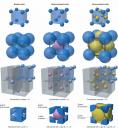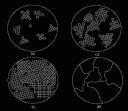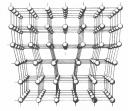What gives metals their strength?
I ran across your column in my quest to find out more about bicycle frame materials (aluminum, steel, titanium, carbon fiber) on a molecular level. I am a 7th grade teacher and i am putting together a unit about the Science of Cycling. I want my students to understand why these different materials have the properties they do on a molecular level. Why is titanium so strong? Is it that all of the particles are so clumped together? I dont know if that makes complete sense but i am trying to grasp why these materials have these certain characteristics and if we looked at a particle level, what would it look like?
Can you help me??
Thanks!
 Metallic Atomic Structure:
Metallic Atomic Structure:
All metals have a crystalline structure made up of «close packed» atoms. The atomic nuclei are in fixed positions while the electrons can migrate. This gives metals their ability to conduct heat and electricity well. The crystal arrangements are better represented by spheres in what’s called a unit cell. There are three main types of packing in the transition metals: Face-Centred Cubic (FCC), Body-Centred Cubic (BCC) and Hexagonal Close Packed (HCP). The packing densities of BCC, FCC and HCP structures are 68, 74 and 74% respectively. The size of the nuclei vary according to the type of element.
 Metallic Microstructure:
Metallic Microstructure:
The atoms in a metallic solid are arranged in close packed crystalline arrangements. However, during solidifaction of a molten metal, different regions are forced to crystallise at the same time. This gives rise to various «grains». Within each grain, the atoms are arranged regularly; it is the spatial orientation of this ordered array that differs between these grains. The sizes of grains normally vary from microns to inches. Grains can be seen with the naked eye in galvanized metal sheet (zinc plated steel), but they are usually microscopic. Generally speaking, the faster the cooling process, the smaller the grain size. Grains are also highly dependent on the forming processes involved in manufacturing a metal. A smaller grain size increases strength on the premise that it is difficult for dislocations to cross grain boundaries.
Keep in mind that whole grains can also slip past each other – the movement primarily occurs at the grain boundaries. There are a limited number of planes through which atoms can slide over one another in these systems, called «slip planes». This gives metals the ability to plastically deform. For example, the HCP structure doesn’t have so many slip planes available as FCC and BCC structures, therefore HCP metals (Cadmium, Zinc, Magnesium, Scandium, Titanium, Zirconium, Cobalt, Beryllium) tend to be more brittle than either FCC metals (Iron, Aluminium, Copper, Gold, Silver, Nickel, Lead) or BCC metals (Vanadium, Tungsten Chromium, Molybdenum, Tantalum).
Single crystal metals:
It is possible to create a metallic object made up of what’s called a single crystal. This is merely an object with a very carefully controlled solidification process, resulting in a very large single grain. The prime example are silicon single crystals used in integrated circuit manufacture. As for structural applications, jet turbine blades are also made of single crystal superalloys. At higher temperatures, they don’t stretch as much as poly-crystalline metals. The proper term for that is creep, movement which for the most part occurs at grain boundaries in metals. Although single crystal metals minimise this phenomonen, they aren’t significatly stronger in other respects since they still contain defects.
 Defects in Metals:
Defects in Metals:
Although metals can be thought of as polycrystalline, the structure is by no means perfect. For example there are dislocations and point defects where atomic bonding is mis-matched. The density of defects can be on the order of trillions per mm³. Cold working increases the dislocation density. Indeed, there are so many existing defects in metals that an increase in their number actually increases strength at the expense of ductility (dislocations become entangled and are prevented from moving).
Metal alloys are almost always stronger than metallic elements. The reason for this is that the introduction of a ‘foreign’ atom results in significant lattice strain due to its different size, further anchoring dislocations.
Strength of Fibres:
If you take any material and produce a fibres out of it, you will find that the fiber exhibits a much higher strength than the bulk material. There is one simple reason for this: smaller objects have less chance of containing critically-sized defects. A perfect defect-free metal has a theoretical strength several orders of magnitude greater than ordinary metals. Apart from the elimination of defects, the reason for the high-strength of carbon fibres is that they contain directional covalent bonds, meaning that the Carbon-Carbon bonds are aligned with the application of external forces. This will surely be covered in another article…




Discussion Area - Leave a Comment